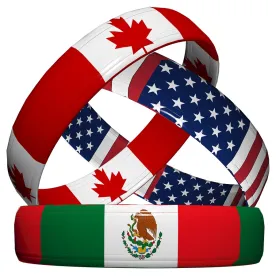The business community, lawmakers and even workers across North America breathed a collective sigh of relief on October 1, 2018, after the renegotiated NAFTA agreement was unveiled. Following negotiations that had become acrimonious, and fears that Canada might be left out, the newly dubbed United States-Mexico-Canada Agreement (USMCA) yielded significant but workable changes to cross-border trade on the continent.
There are winners and losers from the pact, however. The devil is in the details of the 1,100-plus page text. The implications for business are significant and go far beyond those summarized by the media. But at a minimum, USMCA, if ratified, would maintain the vigorous tariff-free arrangement that has underpinned $1.25 trillion in cross-border trade. The agreement would bring a much-needed update to the rules, with modernized intellectual property (IP) provisions and chapters on digital trade, anticorruption, customs and trade facilitation and other improvements. It would maintain Mexico’s status as an attractive place to manufacture, improve dispute settlement processes largely pushed by Canada and provide certainty to the overall character of one of the largest and most reliable trading regions among the three countries. In the meantime, the completion of negotiations gives the business community greater clarity about the future, without which investment and output had suffered.
Of course, the new deal will not go into effect immediately. NAFTA is likely to continue governing North American trade for 18 months or more, as most of the key changes take effect in 2020 or later. After the leaders of the three countries sign USMCA, the legislatures need to ratify it. We believe all three countries are more likely than not to do so, given that the alternative is a possible end to the trade zone, which has been implicitly rejected due to the effort needed to complete USMCA text. After it is ratified, each country will need to write rules and adopt conforming legislation.
For the U.S. Congress, the final USMCA text alleviates many lawmakers’ concerns. For instance, Canada remains part of the trade zone. While the agreement includes a sunset clause, it kicks in after the current U.S. administration is out of office. The biggest industry-specific changes — for instance, an attempt to increase wages for Mexican auto workers and elevated regional content requirements in the sector — are the ones that most companies can adapt to. Finally, USMCA pries open Canadian dairy markets, which will play well in key districts.
That said, with Democrats winning the majority in the U.S. House of Representatives in the November 2018 midterm elections and Republicans continuing to control the Senate, the vote may occur at a time of heightened partisan tension. In the days after the three nations’ negotiators signed off on USMCA, some lawmakers warned that Congress would closely scrutinize the details. Senator John Cornyn, Republican of Texas and majority whip, said passage was “not a foregone conclusion.” Senator Ron Wyden, an Oregon Democrat, insisted that it should not be consideredduring a lame-duck session after the midterm elections, but senior Republicans, speaking before the election, said they would do just that if their party lost the House of Representatives.
Now that they control the House, Democrats may face pressure to argue that USMCA does not go far enough to protect U.S. manufacturing jobs. While unions generally regard USMCA as an upgrade from NAFTA, they are still pushing for more. After the deal was announced, the AFL-CIO indicated that it would withhold endorsement until it understands enforcement and implementation details.
In Mexico, USMCA has been well received. Mexican negotiators had consulted closely with the country’s business leaders, who generally see the deal as a reasonable update of NAFTA, and a venue to maintain unrestrained market access to the U.S. market, but for steel and aluminum, discussed below. Key provisions affecting the Mexican industry — such as a requirement that by 2023, 40-45 percent of the work on a car or truck be done by workers earning $16 an hour — are less onerous than they seemed when considering the figure given by Mexican Minister of Economy, Ildefonso Guajardo Villarreal, that close to 70 percent of current passenger vehicle production already complies with that requirement. The deal will likely be ratified by Mexico’s newly seated Senate, with its majority comprised of legislators akin to President-Elect Andrés Manuel López Obrador who will be sworn in on December 1, 2018.
USMCA appears to stand a good chance of being ratified in Canada as well, although it has been criticized by both liberals and conservatives. Tracey Ramsey, a member of parliament for Canada’s left-leaning New Democrats, blasted a clause that effectively gives the U.S. veto power over a trade deal between China and Mexico or Canada, which she said is a “severe restriction on Canadian independence.” Conservative leader Andrew Scheer is calling the deal “NAFTA 0.5” because of all the concessions Prime Minister Trudeau agreed to in order to get the deal done. Speaking before Parliament, he derisively quoted President Trump’s economic advisor Larry Kudlow as saying “Canada gave graciously.”






 />i
/>i

